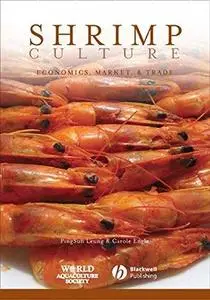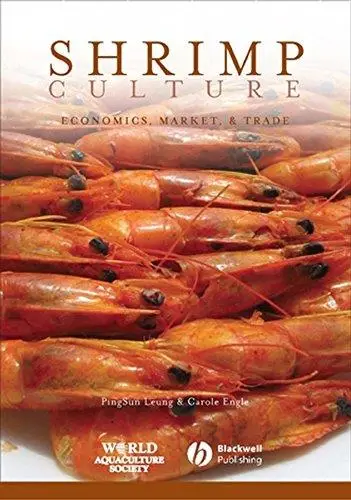Shrimp Culture: Economics, Market, and Trade By
2007 | 335 Pages | ISBN: 0813826551 | PDF | 5 MB
2007 | 335 Pages | ISBN: 0813826551 | PDF | 5 MB
Published in Cooperation with THE WORLD AQUACULTURE SOCIETYShrimp is the most important commodity, by value, in the international seafood trade. The shrimp industry has grown exponentially in the last decades, and growth is expected to continue for years to come. For future success in the shrimp industry, shrimp farmers and aquaculture scientists will find a thorough knowledge of the economics, market, and trade as important as an understanding of disease management or husbandry.Shrimp Culture: Economics, Market, and Trade brings together recent findings of researchers from around the world working in various aspects of the economics of shrimp farming. This volume covers all major aspects of the economics, trade, and markets for shrimp worldwide, with chapters written by experts from major consuming countries such as the U.S.A. and major providers such as China, Thailand and Brazil. The book has been carefully edited by PingSun Leung and Carole Engle, both well known and respected internationally for their work in this area.Shrimp Culture is an essential purchase for everyone involved in this massive industry across the globe.Content: Chapter 1 An Overview of Global Shrimp Markets and Trade1 (pages 3–10): Audun LemChapter 2 Export Performance of Frozen Cultured Shrimp in the Japan, U.S., and Eu Markets: A Global Assessment (pages 11–40): Junning Cai and Pingsun LeungChapter 3 WTO Trade Rules with an Update on the Doha Round Negotiations and A Short Reference to Antidumping Actions (pages 41–52): Audun LmeChapter 4 Structural Changes and Regulations of Imported Shrimp in Japan (pages 53–62): Bith?Hong LingChapter 5 Integrating Supply and Demand Factors in the Diffusion Rates of Aquaculture Technology for the International Shrimp Industry (pages 63–78): Alison M. Keefe and Curtis M. JollyChapter 6 Economic Effects of Components of Best Management Practices for Small?Scale Shrimp Farms in Honduras and Cooperatives in Nicaragua (pages 79–94): Carole Engle and Diego ValderramaChapter 7 Production Performance Economic Indicators and Their Role in the Planning and Assessment of the Sustainable Development of Aquaculture (pages 95–106): Francisco J. Martinez?Cordero and Pingsun LeungChapter 8 Vietnamese Shrimp Farming at A Key Point in its Development: A Review of Issues Examining Whether Development is Being Carried Out in A Sustainable Way (pages 107–132): Pascal Raux, Denis Bailly and Tran Van NhuongChapter 9 Economic Issues in Promoting Sustainable Shrimp Farming: A Case Study of the Rice?Shrimp System in the Mekong Delta (pages 131–142): Donna Brennan, Helena Clayton, Nigel Preston and Tran Thanh BeChapter 10 Utilization of Coastal Areas for Shrimp Farming in Southern Thailand (pages 143–154): Ruangrai TokrisnaChapter 11 A Review of Shrimp Farming in Central Thailand and its Environmental Implications (pages 155–166): Brian W. SzusterChapter 12 Economics of Gei Wai Shrimp Culture in Hong Kong: from Commercial Aquaculture to Bird Production (pages 167–186): Lawrence W. C. Lai, Ken K. H. Lam, F. T. Lorne and S. K. WongChapter 13 An Economic Evaluation of Shrimp Farming Industry in Taiwan (pages 187–196): David S. Liao and I. Chiu LiaoChapter 14 An Overview of China's Cultured Shrimp Industry (pages 197–222): Yongming Yuan, Junning Cai and Pingsun LeungChapter 15 Practices and Economics of Successful Shrimp Farms in the Philippines (pages 223–238): Wilfredo G. Yap and Antonio C. VillaluzChapter 16 The Economics of Shrimp Farming in Selected Asian Countries (pages 239–260): Madan Mohan Dey, Roslina Kamaruddin, Ferdinand J. Paraguas and Ramachandra BhattaChapter 17 Economics and Management of Freshwater Prawn Culture in Western Hemisphere (pages 261–278): Wagner C. Valenti and James H. TidwellChapter 18 Economics of Integrating Nursery Systems into Indoor Biosecure Recirculating Saltwater Shrimp Grow?Out Systems (pages 279–290): Benedict C. Posadas and Terrill R. HansonChapter 19 Comparative Cost of Shrimp Production: Earthen Ponds Versus Recirculating Aquaculture Systems (pages 291–300): Shaun M. Moss and Pingsun LeungChapter 20 Overview of Farming Systems for Marine Shrimp with Particular Reference to Feeds and Feeding (pages 301–314): Albert G. J. Tacon, Sergio F. Nates and Roderick J. McneilChapter 21 A Decision Support System for Efficient Scheduling of Multi?Pond and Multi?Cycle Commercial Shrimp Culture (pages 315–328): Run Yu, Pingsun Leung and Paul Bienfang



